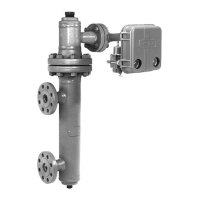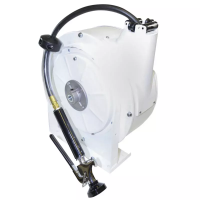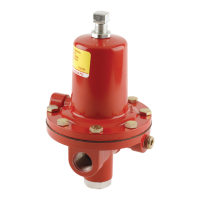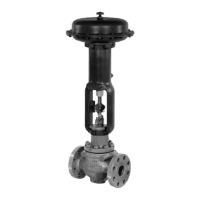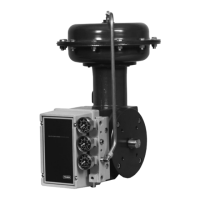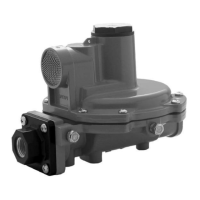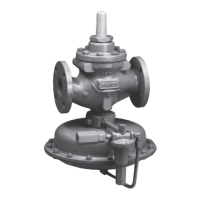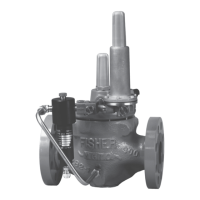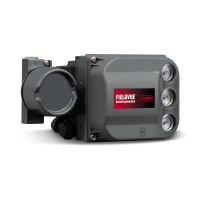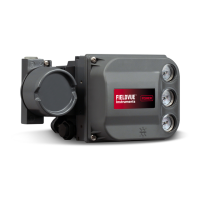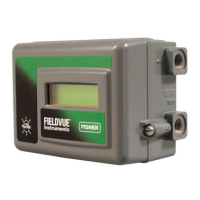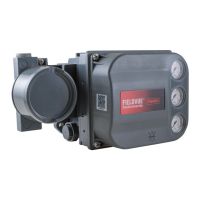2502 Series
20
5. Install and tighten the bearing assembly (key 12) in
the case (key1). Secure the operating arm base or point-
er assembly to the rotary shaft by tightening the hex nut
(key 40, figure 16). Connect the supply and output pres-
sure tubing and perform the calibration procedure.
Changing Proportional, Reset, or
Differential Relief Valve
1. Remove the proportional band valve assembly (key
36, figure 16) by unscrewing it from the relay base
(key 23, figure 16). Install the desired replacement
assembly, or a 1/8-inch (3.2 mm) NPT pipe plug into
the proportional band tapping if testing relay dead
band.
2. To change the reset restriction valve assembly (key
91), remove the two mounting screws (key 182) located
on the back side of case. Install the replacement valve
assembly, and reconnect the tubing connections.
3. Remove the differential relief valve assembly (key
186, figure 16) by removing the two mounting screws
(figure 11) that anchor the valve to the manifold (key
184, figure 16). Install the valve with the arrow pointing
to the same letter(s) as before removal, unless it is
desired to change the relief action.
Testing Relay Dead Band
1. Replace the proportional band adjustment assem-
bly with a 1/8-inch (3.2 mm) NPT pipe plug according
to the Changing Proportional, Reset, or Differential
Relief Valve section.
2. Turn on the supply pressure and set it to 20 or 35
psig (1.4 or 2.4 bar).
3. By changing the process variable and adjusting the
raise level control, set the output pressure to 15 or 30
psig (1.0 or 2.0 bar). While monitoring the output pres-
sure, slowly change the process until an output pres-
sure change can just be detected, and record the val-
ue of the process variable at the detection point.
4. Change the process variable in the opposite direc-
tion until another output pressure change can be de-
tected, and again record the value of the process vari-
able. If the difference between the two recorded
values (the dead band) is more than 0.2 percent of the
maximum displacer length, the relay will have to be
replaced or repaired according to the Changing Relay
and the Disassembling Relay sections.
5. Turn off the supply pressure, remove the pipe plug,
and install the proportional band adjustment assembly.
Changing Relay
The relay may be removed for cleaning or repair, and
must be taken off to remove the lower bellows.
1. On a controller with indicator assembly, loosen the
two lower screws (key 96, figure 17) of the relay case
and slide out the indicator base plate (key 53, figure 16).
2. Disconnect the tubing (key 11, figure 16) from the
relay.
3. Remove both mounting screws, the relay, and the
relay gasket (keys 43, 34, and 22, figure 16).
4. Install a new gasket, the replacement relay if nec-
essary, and both mounting screws. Reconnect the tub-
ing. On a controller with indicator assembly, slide the
base plate under the two lower screws of the relay
case, align the plate so that the pointer will read prop-
erly, and tighten the screws.
Replacing Bellows
Key numbers are shown in figure 16.
1. To gain access to the lower bellows, remove the
relay according to the Changing Relay section.
2. Remove the upper and lower bellows frame screws
(key 96) that hold both bellows assemblies to the bel-
lows frame. Unscrew each bellows from the spacer
(key 98), being careful not to lose the O-ring (key 57,
not shown) from the spacer end of the bellows.
3. Inspect each bellows and O-ring and replace if nec-
essary, using an unpainted bellows for a 3 to 15 psig
(0.2 to 1.0 bar) range and a red bellows for a 6 to 30
psig (0.4 to 2.0 bar) range. Be sure to install the O-ring
at the spacer end of the bellows.
4. Install each bellows by screwing it down over the
stud (key 97, not shown) protruding from each end of
the spacer. Secure with a bellows frame screw, and
install the relay according to the Changing Relay sec-
tion if it was removed.
5. Perform the calibration procedure and any other
necessary part of the calibration sequence.
Reversing Action
Note
The following procedure will be neces-
sary to restore previous action if the
mounting method has been changed.
Key numbers are shown in figure 16.
1. Remove two screws (keys 63 and 64), two seal
rings (key 55), and the nozzle block (key 101). Check
seal ring condition and replace rings as necessary.
2. Install the nozzle block, seal rings, and screws on
the opposite side of the beam as shown in figure 15.
Disconnect the proportional band tubing (key 76) and
one of the two pieces of reset tubing (key 75) from the
bellows frame (key 94) and reconnect them in the
proper orientation as shown in figure 15.
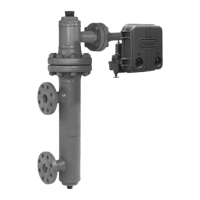
